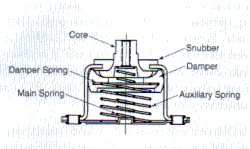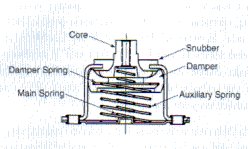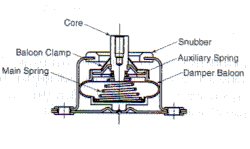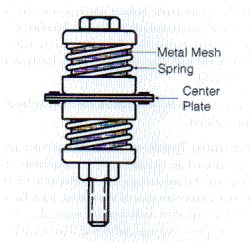Engineering Support
Isolators and Materials
— Isolators are made from a wide variety of resilient media having diverse characteristics. Each type of isolator has characteristic properties and is particularly suited to certain specialized applications. To make the best use of available isolators, the designer should understand the basic properties of each type. He should also be familiar with the requirements for isolators for various types of equipment, as indicated in the preceding discussions. Keep in mind that not all isolators can be manufactured out of any material.
Elastomeric Isolators
Elastomers are well adapted for use in shock isolators because of their high energy storage capacity and because the convenience of molding to any shape makes it possible to attain the linearity or nonlinearity required for adequate shock isolation.
Most elastomeric isolators cannot be constantly subjected to large strains. An isolator with a large static deflection may give satisfactory performance temporarily but it tends to drift or creep excessively over a relatively short period of time. Opinions on maximum permissible static strain vary widely, but it may be taken as a conservative limitation that elastomers should not be continuously strained more than 10 to 15% in compression, nor more than 25 to 50% in shear. These rules of thumb are often used to determine the maximum load capacity of a given isolator.
In spite of the limitations of elastomeric materials used in isolators, the overall advantages far outweigh the disadvantages and make elastomers the most highly desirable type of resilient media for isolators.
With this type of isolator, the elastomer is strained in compression when the load is applied along "A" direction. Stiffness in any direction perpendicular to the "A" direction, such as the "B" direction, is a function of the shear modulus of the elastomer, and tends to be relatively low compared compressive stiffness.
Springs
Metal springs can be used as vibration isolators. In some instances, these types of isolators work well. Frequently, the lack of damping in these type of isolators forces them to experience extremely violent resonances conditions.
Combination Spring-Friction Damper
To overcome the disadvantages of little or no damping in coil springs, friction dampers can be designed in parallel with the load-carrying spring. These types of isolators are widely used in practice. An example of this is illustrated in Figure 13.
In this construction, along the vertical axis a plastic damper slides along the walls of a cup housing, and the normal force is provided by a radial damper spring. For horizontal damping, a central metal core which is directly attached on its top side to the equipment bears on the damper on its bottom size. The normal force is provided by the weight of the equipment, and damping results from the sliding during horizontal excitations. Transmissibility values of about 2 are exhibited by using this type of spring/damper combination.
| Properties | Natural Rubber | Neoprene | Hi-Damp® Silicone | Barry LT Compound |
|---|---|---|---|---|
| Adhesion to Metal | Excellent | Excellent | Good | Very Good |
| Tensile Strength | Excellent | Excellent | Good | Excellent |
| Tear Resistance | Good | Good | Fair | Good |
| Compression Set Resistance | Good | Fair | Fair | Good |
| Damping Factor, C/Cc (approx.) | 0.05 | 0.05 | 0.15 | 0.12 |
| Operating Temperature (max) | 180°F | 180°F | 300°F | 200° |
| Stiffness Increase (approx.) @ -65°F | 10x | 10x | <2x | 2x |
| Oil Resistance | Poor | Good | Fair | Fair |
| Ozone Resistance | Poor | Good | Excellent | Fair |
| Resistance to Sunlight Aging | Poor | Very Good | Excellent | Good |
| Resistance to Heat Aging | Fair | Good | Excellent | Good |
| Cost | Low | Low | High | Moderate |
Table 2: Relative properties of elastomers used as the resilient media for isolators
Combination Springs with Air Damping
Another method of adding damping to a spring is by use of an air chamber with an orifice for metering the air flow. An example of this type of isolator is illustrated in Figure 14. In this construction the load-carrying spring is located within the confines of an elastomeric damping balloon. The air chamber is formed by closing the balloon with a cap which contains an orifice or the force flow metering. Under dynamic excitations the air in the balloon passes through a predetermined sized orifice by which damping is closely controlled. Transmissibilities generally under 4 result with this type of design.

Figure 13: Isolator using friction damped spring.

Figure 14: Isolator using air damped spring.
Air-damped springs have some specific advantages over seemingly similar friction damped designs with respect to isolating low-level inputs. Air damping, a form of viscous damping, causes the damping forces to be reduced if the input levels are reduced.
With friction damping, the friction force is constant. In practice, this means that the damping ratio is effectively increased with the input levels decreased. In summary, air damped isolators are best suited for isolating low-level vibrations, while friction damped isolators are usually ideal for higher-level vibrations.
Combination Springs with Wire Mesh Damping
For applications where all metal isolators are desired because of temperature extremes or other environmental factors, damping can be added to a load carrying spring by use of metal mesh insterts, Figure 15 illustrates this concept.

Figure 15: Isolator using metal-mesh damped Spring

Figure 16: Isolator with wire mesh load carrying pad
In this construction a knitted mesh wire is formed into a resilient cushion and inserted within the inside diameter of the coil spring. When dynamic loads are applied, the strands of the mesh rub on each other and damping is accomplished. Transmissibilites under 6 are generally exhibited by the spring-wire mesh damper combination.
Wire mesh cushions are sometimes used as isolators without the addition of a spring in parallel. Although transmissibilities of such an isolator range in the region of 4, an isolator so designed has the disadvantage of creep or high compression set. Once the metal pads take a compression set their performance under dynamic conditions is difficult to predict. A example of this type isolator is illustrated in Figure 16.
Pneumatic Systems
This type of isolator utilizes the principle of supporting the static load on an air column. It is particularly useful where low fn systems are required; that is, 0.5 to 3 Hz region. An air spring enables the system to have a "zero" static deflection under load. This particularly noteworthy since a conventional spring system would need to deflect a magnitude of 3.3 feet to acquire a 0.5 Hz natural frequency and 1.1 in. for 3 Hz natural frequency. Pneumatic isolators can use a method of damping called sprung damping. This allows the isolator to have very high damping at resonance, but very low damping in the isolation region. A Barry pneumatic isolator which follows the laws of relaxation of sprung damping offers the benefits of very low T at resonance (generally 1.5) and yet offer a high degree of isolation in the high-frequency regions by acting as an undamped spring.
This website contains information on the SLM Series of pneumatic isolators.
Miscellaneous Type of Isolators
Other materials sometimes are used for vibration and shock isolators. Wool felt is often used for mounting entire machines but is seldom designed as a component part of a machine. A similar situation exists with regard to cork. Another material in the same category is neoprene impregnated fabric. The manufacturers of spun glass have also suggested the use of this material for the isolation of vibration. All of these materials appear to have characteristic advantages for particular installation. However, the ability of these materials are not well documented in the technical literature.
Little difficulty is encountered in the design of isolators using elastomeric materials or metal springs. The performance characteristics of these materials are very predictable under dynamic conditions.
Contact Us
The personal data collected are processed, the responsibility of which is HUTCHINSON AEROSPACE & INDUSTRY INC. company, in order to respond to your request for information and/or for the purpose of commercial prospecting. Mandatory fields to be completed are marked with an asterisk. The legal basis for the processing is your consent, which you may withdraw at any time, without prejudice to previous processing operations. Personal data are reserved for the use of the HUTCHINSON group and may only be transmitted to companies of the HUTCHINSON group and/or commercial partners for commercial purposes, if you have expressly consented to this.
In accordance with the regulation relating to personal data (GDPR), you have the right of access, rectification and erasure of your personal data, as well as the right of opposition to their processing. You may request the disclosure of your personal data and you have the right to define guidelines for the treatment of your personal data after your death. You can also request the portability of your data as well as the limitation of their processing, and/or file a complaint to your local authority.
You can exercise your rights and ask us about the processing of your personal data by contacting us at the following email address: [email protected]
To find out more read our Privacy and Cookies Policy.
